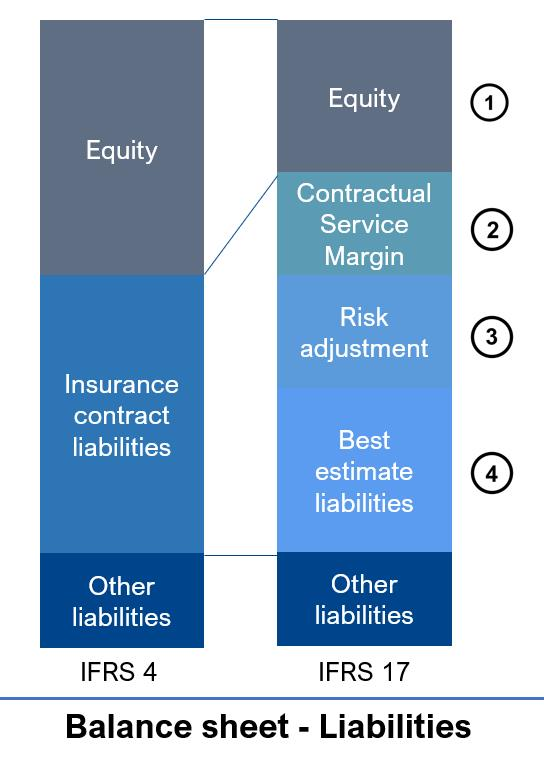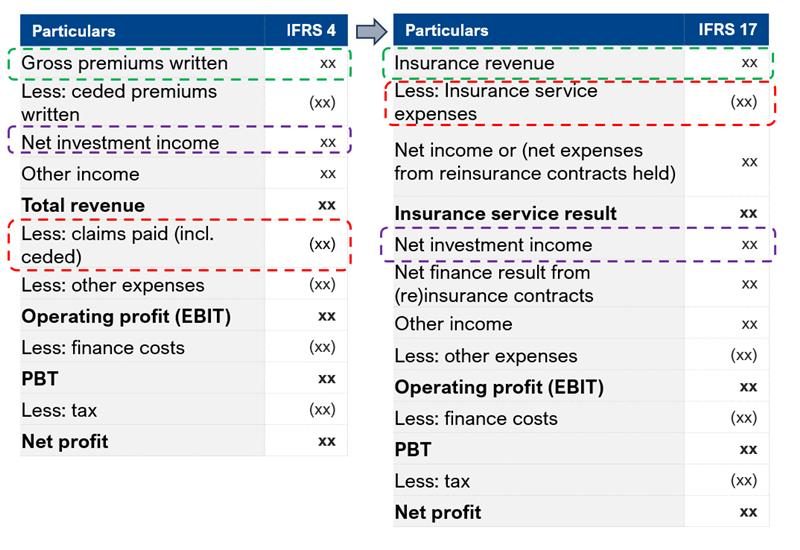IFRS 17: A Move Toward Standardized Insurance Reporting
Published on 15 Dec, 2023

After years of intensive discussions and overcoming major concerns of the insurance industry, the International Accounting Standards Board (IASB) issued its new insurance contracts standard IFRS 17 (formerly known as IFRS 4 Phase II), effective for annual periods beginning on or after January 1, 2023. Insurance companies using IFRS standards started reporting as per the new standards in 1H23 and 9M23 with one year restated comparative information. Around 450 insurers are listed under IFRS, with an asset base of USD 13 trillion.
IFRS 17 increases the simplicity and transparency of financial statements. Earlier, under IFRS 4, it was difficult to analyze insurance companies due to a lack of clarity regarding core insurance and investment results, unlike other industries where investment income is recognized after recording the cost of goods sold and operating expenses. The new standard removes this difficulty, making it easier for investors to analyze insurance companies. The main impact is on life insurance companies or the life segment of insurance companies, as IFRS 17 follows a more conservative framework than IFRS 4.
Purpose behind the new accounting standard:
- The objective of IFRS 17 is to provide a more simplified version of the income statement by clearly distinguishing net insurance results and investment results, enabling investors and analysts to compare insurance companies across different countries, industries, and contracts.
- The new standard also provides a consistent framework of accounting for different insurance contracts, removing existing inconsistencies.
Impact:
- IFRS 17 will have a major impact on the life segment's revenues, especially life insurance contracts with an annuity. This is because the new standard follows a conservative accounting approach by recognizing expected profits when insurance services are provided and recognizing expected losses once discovered.
- Considering the top life insurers in Europe in terms of asset base, restated revenues of 1H22 (June-2022) were lower by double-digit year-on-year (see appendix for more details).
- In terms of equity for FY2022 (Dec-2022), Aegon Ltd and Swiss Life Holding reported a drop in low double-digits, while Allianz’s restated equity was lowered slightly.
- The Property and Casualty segment will have less impact as the contract is short term (less than 1 year) and liability arises only when the insurance contract is claimed.
- The new standards will change the presentation of financial statements and information. However, the fundamentals of the sector, business strategy, capital management approach, or outlook of insurance companies will remain unaffected.
- The key point to highlight is that the impact will be clear a few quarters down the line when companies publish further quarterly reports.
Rating implications:
- S&P, Moody’s, and Fitch expect no rating action with the implementation of the new standard unless the risk structure or capitalization strategy of the respective insurance company is changed.
Key changes:
Rise in Life & Health liabilities and profit recognition results in significant initial drop in equity:

Source: Insurance company’s website, Aranca research
- Shareholder’s equity will reduce as the deposit amount received from policyholders (particularly from annuity contracts) was recorded in equity via retained earnings (as per IFRS 4). As per IFRS 17, this deposit will be recorded as a contractual service margin (CSM) and will be released as the insurance service is provided.
- IFRS 17 is based on the concept that profit is recognized only when the associated service is provided. Consequently, unearned profit for insurance services — CSM — is presented as part of the insurance contract liability on the insurer’s balance sheet.
- The risk adjustment (RA) is a simple concept that reflects the uncertainties around the value of future cash flows. It is a non-financial measure associated with fulfilling contractual liabilities; for example, issues with policyholders, and environmental or regulatory changes.
- The best estimate liabilities (BEL) represent the present value of future liability due to insurance contracts; for example, directly attributable claims expenses.
More simplified income statement, clearly distinguishing net insurance and investment income:

Source: Insurance company’s website, Aranca research
- Insurance revenue will be lower than IFRS 4 as it will reflect the amortization of CSM over the term of the contract (only for life insurance) as insurance services are provided.
- Insurance service expenses include claims expenses.
- Insurance service results provide net underwriting results, making it easier for investors to compare insurance companies.
- Investment income is recorded after the insurance service result (underwriting result), making the accounting practice in line with other financial sectors like banking and investment management.
Illustrative revenue recognition for life annuity contracts:

Source: Aranca research
- The graph above illustrates the impact on the life insurance segment’s revenues due to change in time of revenue recognition as per the IFRS 17 standards.
- Under IFRS 4, there was significant recognition of day one profit to the income statement. As a result, writing of a new annuity business has been beneficial from an earnings perspective. However, there was much smaller ongoing profit recognition over the remaining life of the product.
- Under IFRS 17, driven by the inclusion of CSM, there is no day one profit recognition, rather it is amortized over the period of the contract. IFRS 17 will result in higher ongoing profits than IFRS 4 (in exchange for no day one profit), with the ultimate economics being unchanged.
Rating agency views:
S&P:
- The accounting change is, by itself, unlikely to trigger rating actions. That said, if insurers change their risk appetite or capitalization strategy following the introduction of IFRS 17, it could lead to rating actions.
- Preparing for the new standard has, at times, been arduous, but S&P Global Ratings anticipates that the improved transparency will be worth it.
- IFRS 17 should make it easier to identify and compare how insurers and reinsurers generate profits and handle risks.
Moody’s:
- Moody’s does not expect the application of the new accounting standards to directly affect the underlying economic risk or expected cash flows of in-force business.
- It adds that the new standards do not directly affect regulatory financial reporting and regulatory capital for most regulatory jurisdictions. However, it will affect the presentation of financial statements, including revenue, net income, equity, and insurance liability.
Fitch:
- IFRS 17 is an improvement on IFRS 4, making financial statements more transparent despite the initial imperfections.
- Fitch expects IFRS 17 results to become more (but not fully) comparable over the next two years, with insurers, analysts, and investors gradually developing enough confidence in the new accounting standard to use it as a basis for decision-making.
- In the meantime, Fitch does not expect IFRS 17 to significantly affect insurers’ business models or their credit ratings.
Appendix:
The table below showcases comparison between IFRS 4 revenue and IFRS 17 revenue for selected top life insurance companies (in terms of asset base) of Europe.
| Company Name (All figures in EUR mn unless stated) | Country | Total Assets | Insurance revenue 1H22 |
Insurance revenue 1H22 - restated |
Net profit 1H22 |
Net profit 1H22 - restated |
% change revenue |
% change net profit |
|---|---|---|---|---|---|---|---|---|
| AXA SA | France | 696,697 | 53,687 |
40,896 |
4,207 | 3,925 | -23.80% |
-6.70% |
Assicurazioni Generali |
Italy |
519,051 | 38,103 |
22,593 |
1,577 |
1,085 |
-40.70% |
-31.20% |
| Credit Agricole Assurances S.A. | France | 409,389 | 19,026 |
6,506 |
780 |
471 |
-65.80% |
-39.60% |
| Aegon Ltd. | Netherlands | 400,936 | 7,532 |
5,506 |
64 | 46 |
-26.90% |
-28.10% |
| Allianz Lebensversicherungs-AG | Germany | 286,576 | 41,128 |
42,055 |
2,479 | 2,675 |
2.30% |
7.90% |
| Swiss Life Holding AG | Switzerland | 220,954 |
7,918 |
3,721 |
642 |
710 |
-53.00% |
10.60% |
| NN Group N.V. | Netherlands | 217,110 |
7,636 |
5,154 |
2,013 |
1,727 |
-32.50% |
-14.20% |
| Intesa Sanpaolo Vita S.p.A | Italy | 148,275 | 4,674 | 1,491 |
440 |
427 |
-68.10% |
-3.00% |
| Average | | |
|
|
-38.60% |
-13.00% |
Source: S&P Capital IQ, Aranca research

